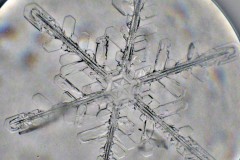 Crystallography has been an immensely powerful influence in science over the past century, yet it is rarely a government priority and is scarcely known by the public. UNESCO and the International Union of Crystallography (IUCr) are planning to change that next year with an ambitious, worldwide schedule of activities.
Crystallography has been an immensely powerful influence in science over the past century, yet it is rarely a government priority and is scarcely known by the public. UNESCO and the International Union of Crystallography (IUCr) are planning to change that next year with an ambitious, worldwide schedule of activities.
The article in the TWAS Newsletter surveys some of the activities that were discussed when an IUCr delegation visited TWAS recently. Many of the events will be focused on the developing world, IUCr President G.R. Desiraju (TWAS Fellow 2002) said in a recent email interview.
 When X-rays are fired at crystalline materials, researchers can study the diffraction patterns to see the molecular and atomic structure of matter. In contemporary applications, crystallography uses many techniques allowing structural studies at an increasingly small scale, sometimes using X-rays generated by powerful synchrotron sources. Crystallography is essential in a variety of fields, including materials science; analysis of crystalline structures allows scientists and engineers to create new materials that have considerable value in everyday life.
When X-rays are fired at crystalline materials, researchers can study the diffraction patterns to see the molecular and atomic structure of matter. In contemporary applications, crystallography uses many techniques allowing structural studies at an increasingly small scale, sometimes using X-rays generated by powerful synchrotron sources. Crystallography is essential in a variety of fields, including materials science; analysis of crystalline structures allows scientists and engineers to create new materials that have considerable value in everyday life.
Crystallography "is easy to do, relatively inexpensive, extremely accurate, and generally independent of sophisticated infrastructure", Desiraju said. "Thus, in the developing world, it is the single most important technique that has led to a rapid increase in the number of quality publications in respected international journals. It provides training that fine-tunes desirable qualities such as precision and accuracy in scientific research, and encourages a quantitative bent of mind."
 TWAS Executive Director Romain Murenzi welcomed the focus on this field. "Crystallography should be a prime field for focus and investment by policymakers and educators in developing nations", he said after the meeting with IUCr officials. "Nations that develop skill in this field create their own power – the power to address challenges in food production, clean water and health. That makes the International Year of Crystallography very important, and we look forward to working with Prof. Desiraju and his colleagues."
TWAS Executive Director Romain Murenzi welcomed the focus on this field. "Crystallography should be a prime field for focus and investment by policymakers and educators in developing nations", he said after the meeting with IUCr officials. "Nations that develop skill in this field create their own power – the power to address challenges in food production, clean water and health. That makes the International Year of Crystallography very important, and we look forward to working with Prof. Desiraju and his colleagues."
The IUCr already funds the successful 'Crystallography in Africa' education and training programme, and ambitious outreach is also planned for Latin America and Asia.
An opening ceremony for the International Year of Crystallography is scheduled for 20-21 January 2014 at the UNESCO headquarters in Paris. Other events will be held throughout the year.
 Also in the latest issue of the TWAS Newsletter:
Also in the latest issue of the TWAS Newsletter:
- New TWAS President Bai Chunli discusses his vision for the future of TWAS.
- TWAS has more than doubled its PhD fellowships thanks to a new pact with the Chinese Academy of Sciences, the COMSATS Institute of Information Technology and the World Meteorological Organization.
- Leaders in science and diplomacy from more than a dozen nations, convened in a roundtable co-organized by TWAS, explored how revitalize scientific research connections between North Africa and Central Europe.
- Five researchers from Africa, the Middle East, Asia and Latin America were honored earlier this year with the 2013 Elsevier Foundation Awards for Early Career Women Scientists in the Developing World. The awards are sponsored by The Elsevier Foundation, the Organization for Women in Science for the Developing World (OWSD), and TWAS.
- IAP, the global network of science academies, urges scientists to take the lead in solving the world's greatest challenges.
Sean Treacy and Edward W. Lempinen

